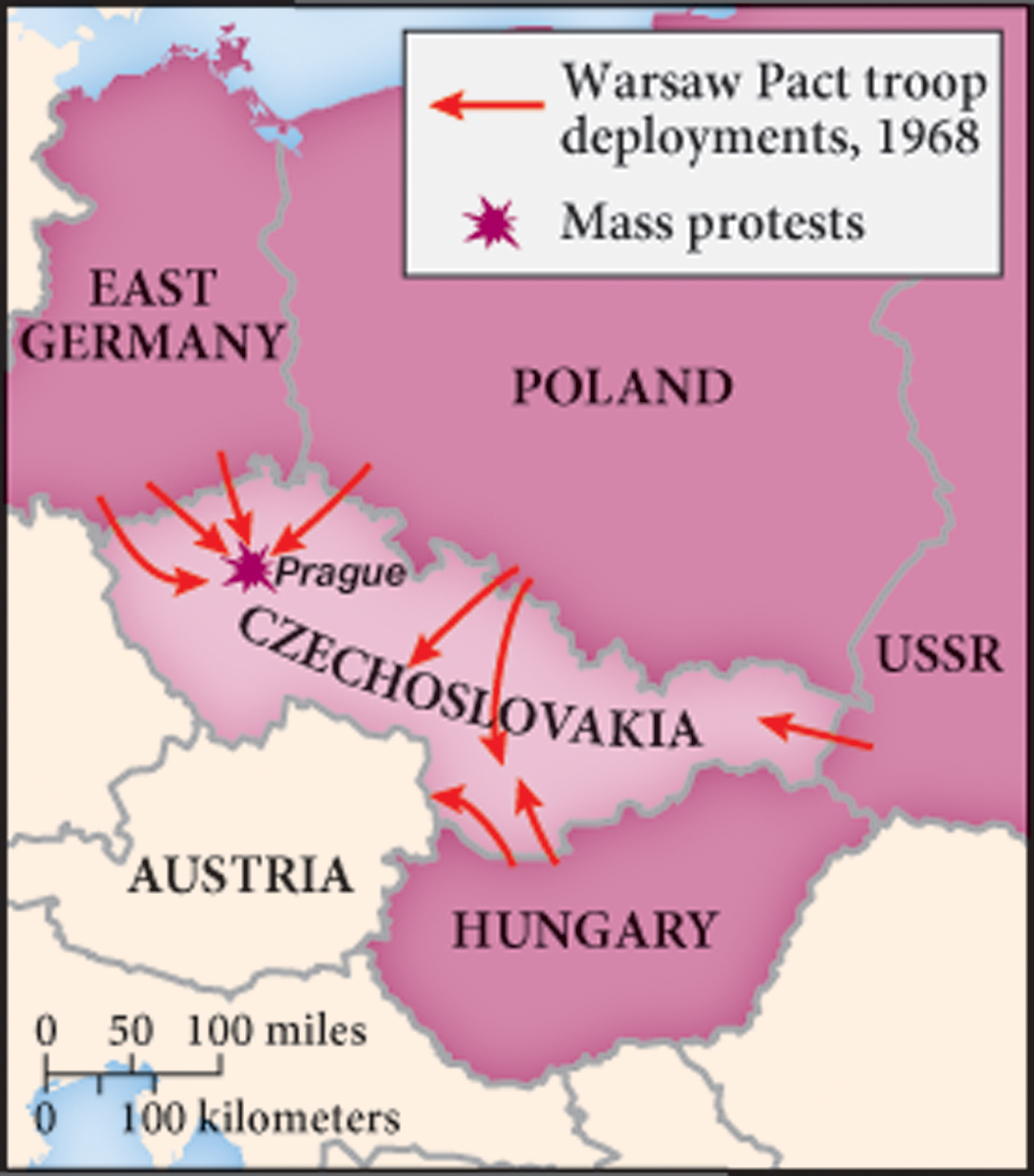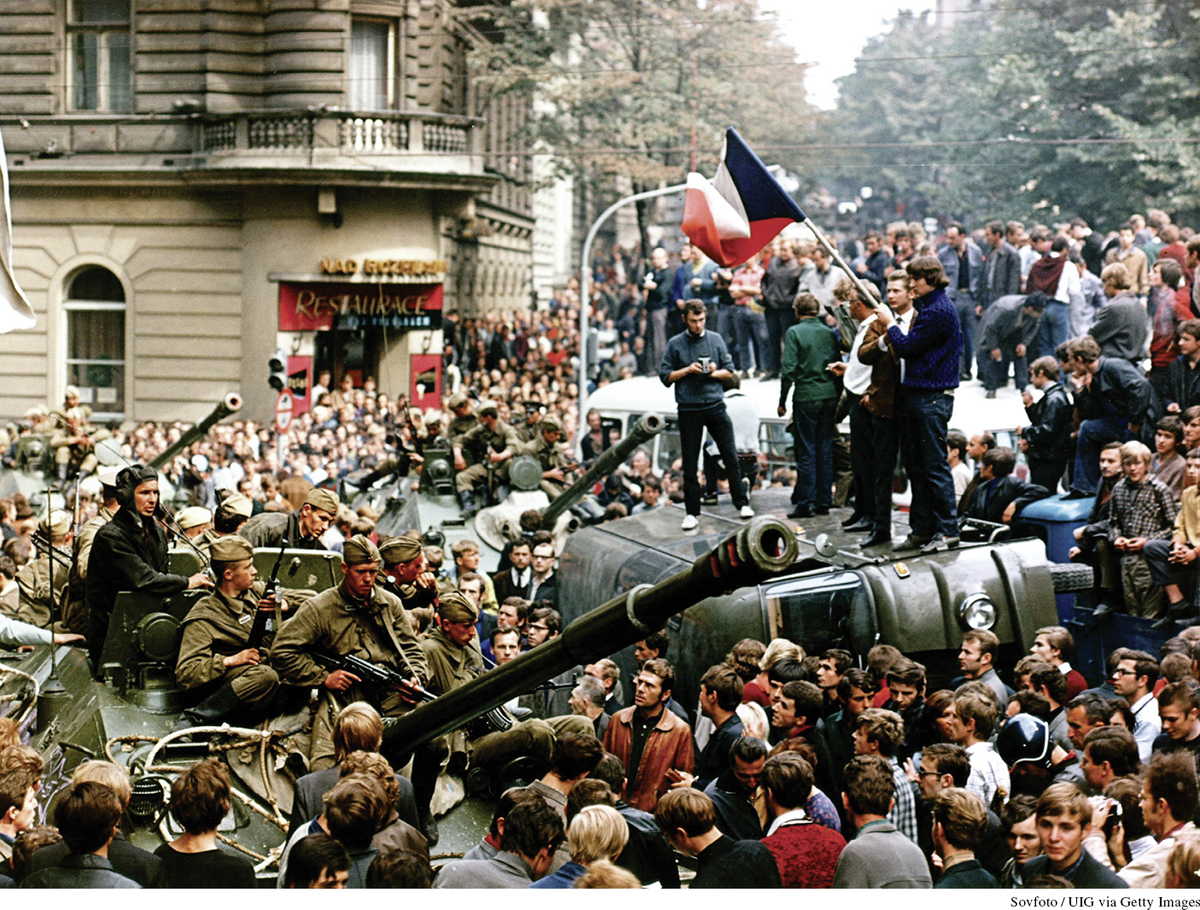1968: Year of Crisis
1968: Year of Crisis
Calls for reform finally boiled over in 1968. In January, on the first day of Tet, the Vietnamese New Year, the Vietcong and the North Vietnamese attacked more than one hundred South Vietnamese towns and American bases, inflicting heavy casualties and fueling the antiwar movement around the world. On April 4, 1968, a white racist assassinated civil rights leader Martin Luther King Jr. Riots erupted in more than a hundred cities in the United States as African Americans vented their anguish and rage. Rejecting King’s policy of nonviolence, rioters rampaged through grim inner cities, chanting “Burn, baby, burn.” On U.S. campuses, bitter clashes over the intertwined issues of war, technology, racism, and sexism closed down classes.
Similar student unrest erupted across the globe, most dramatically in France. In January, students at the university in Nanterre, outside of Paris, had gone on strike, invading administration offices to protest what they saw as a second-rate education. They called themselves a proletariat—an exploited working class—as worker activists had done for more than a century. They did not embrace Soviet communism but rather considered themselves part of the New Left, not the old Communist or Socialist left.
When students at the prestigious Sorbonne in Paris also took to the streets in protest, police assaulted them. French workers joined in the protest. Some nine million went on strike, occupying factories and calling not only for higher wages but also for participation in everyday decision making. The combined revolt of youth and workers looked as if it might spiral into another French revolution. President Charles de Gaulle sent tanks into Paris, and in June he announced a raise for workers. Many citizens, having grown tired of the street violence, the destruction of so much private property, and the breakdown of services such as garbage collection, began to sympathize with the government instead of the students. The revolutionary moment passed.

By contrast, the 1968 revolt in Prague began within the Czechoslovak Communist Party itself. At a party congress in the autumn of 1967, Alexander Dubček, head of the Slovak branch of the party, had called for more social and political openness, striking a chord among frustrated party officials, technocrats, and intellectuals. Czech citizens began to dream of creating a new society—one based on “socialism with a human face.” Reform-minded party delegates elevated Dubček to the top position, and he quickly changed the Communist style of government by ending censorship, instituting the secret ballot for party elections, and allowing competing political groups to form. “Look!” one little girl in the street remarked as the new government took power. “Everyone’s smiling today.” The Prague Spring had begun as people bought uncensored publications, packed uncensored theater productions, and engaged in nonstop political debate.
Dubček faced the enormous problem of negotiating policies acceptable to both the USSR and reform-minded citizens. Fearing change, the Polish, East German, and Soviet regimes threatened the reform government daily. When Dubček failed to attend a meeting of Warsaw Pact leaders, Soviet threats intensified until finally, in August 1968, Soviet tanks rolled into Prague in a massive show of force. Citizens tried to halt the return to Communist orthodoxy through sabotage: they removed street signs to confuse invading troops, and merchants refused to sell food or other commodities to Soviet troops. The determined Soviet leadership gradually removed reformers from power, however. Jan Palach and other university students immolated themselves the following January, as governments around the world worked to stamp out criticism of the cold war order.

The protests of 1968 challenged the political direction of Western societies, but little turned out the way reformers hoped as governments adopted conservative solutions. In November 1968, the Soviets announced the Brezhnev Doctrine, which stated that reform movements, as a “common problem” of all socialist countries, would face swift repression. In the early 1970s, the hard-liner Brezhnev clamped down on critics, shattering the morale of dissidents in the USSR. “The shock of our tanks crushing the Prague Spring . . . convinced us that the Soviet colossus was invincible,” explained one pessimistic liberal. In 1974, Brezhnev expelled author Aleksandr Solzhenitsyn from the USSR after the publication of the first volume of The Gulag Archipelago (1973–1976) in the U.S.-led bloc. Solzhenitsyn documented the story of the Gulag (the Soviet system of internment and forced-labor camps) with firsthand reports about the deadly conditions prisoners endured. More than any other single work, The Gulag Archipelago disillusioned loyal Communists around the world.
The USSR and other Communist countries used both persecution of ordinary citizens and the “soft” power of the new medium of television to reestablish order. Soviet psychologists, working with the government, certified the “mental illness” of people who did not play by the rules; thus, dissidents wound up as virtual prisoners in mental institutions. In a revival of tsarist Russia’s anti-Semitism, Jews faced educational restrictions (especially in university admissions) and severe job discrimination. Soviet officials commonly accused Jews of being “unreliable.” In Czechoslovakia, where by 1970 some 80 percent of households had TV, government writers created a new batch of soap operas featuring heroines who taught their families to replace activism in the public sphere with the contentment of private life. Heroes selflessly traveled to the West for their jobs, only to return disillusioned by its faults.
Despite these efforts, the brain drain of eastern European intellectuals to the West increased into the 1970s and beyond. The modernist composer György Ligeti had left Hungary in 1956, after which his work was celebrated in concert halls and in such classic films as 2001: A Space Odyssey. From exile in Paris, Czech writer Milan Kundera enthralled audiences with The Book of Laughter and Forgetting (1979) and The Unbearable Lightness of Being (1984). Kundera claimed that the Soviet regime in Czechoslovakia depended on making people forget. The memory of fallen leaders was ruthlessly erased from history books, for instance, and individuals tried to block out grim reality by engaging in lots of sexual activity. Like the migrants from fascist Germany and Italy in the 1930s, newcomers—from noted intellectuals to skilled craftspeople and dancers—enriched the culture of those countries that welcomed them.
REVIEW QUESTION What were the main issues for protesters in the 1960s, and how did governments address them?
In the United States, the reaction against activists was different, though restoring order ultimately succeeded there, too. Elected in 1968, President Richard Nixon (1913–1994) promised to bring peace to Southeast Asia, but in 1970 he ordered U.S. troops to invade Cambodia, the site of North Vietnamese bases. Campuses erupted again in protest, and on May 4 the National Guard killed four students and wounded eleven others at a demonstration at Kent State University in Ohio. Nixon called the victims “bums,” and a growing reaction against the counterculture led many Americans to agree with one citizen who declared that the guardsmen “should have fired sooner and longer.” In 1975, a determined North Vietnamese offensive defeated South Vietnam and its U.S. allies and forcibly reunified the country. A strong current of public opinion turned against activists, born of the sense that somehow they—not the war, government corruption, or the huge war debt—had brought down the United States. Both superpowers were being tested, almost to the limits.